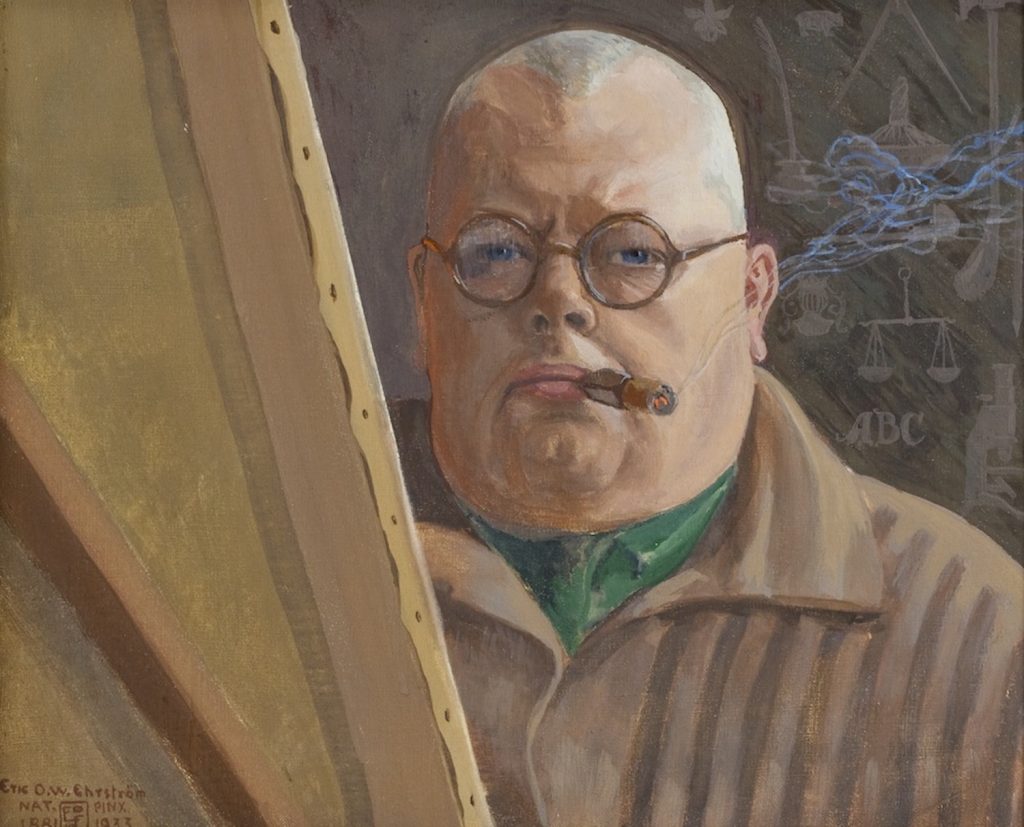Eric O. W. Ehrström – Self-Portrait
09.12.2019
Eric O. W. Ehrström, Self-Portrait 1933, after losing his right arm
In the collections of Gösta Serlachius Fine Arts Foundation, there are several thousand sketches and also finished works by the artist Eric O. W. Ehrström and his wife Olga (born Gummerus).
As an artist, Eric O. W. Ehrström (1881–1934) was exceptionally multifaceted. He designed jewellery, tableware, textiles, furniture, buildings. Erhström was an artisan and industrial designer, who knew the art of metal embossing as well as the work of an enamel- and goldsmith. He made glass and fresco paintings, sculptures, graphics; illustrated and wrote books, drew and painted. He worked as a conservator, teacher, intendant and artistic leader.
Ehrström’s heraldic production is vast. It contains coats of arms, medals, postal stamps, and also product marks. He was a member of Finland’s Sigil Committee and Flag Committee, where the official symbols of the independent republic were planned. The Finnish Royal Crown is also his work.
Ehrström’s interest in nature was professional. He photographed and drew plants and their details, used them as motifs for decoration and ornamentation, and drew illustrations of flora.
Eric O. W. Ehrström studied only one year at the Finnish Art Society’s Drawing School, and after that he was an apprentice to Akseli Gallén at Kalela during 1899–1900, when Gallén was planning the pavilion for the Paris World Exposition. Gallén’s influence is seen in Ehrström’s production, and directed him towards the area of art crafts. Obviously Ehrström got to know Gösta Serlachius through Gallén.
After the Kalela period, Ehrström travelled to Paris in order to learn the art of metal forging. There he met Olga (Olli) Gummerus, to whom he was married in 1903. Olga was Eric’s wife, as well as his companion, his beautiful beloved and the object of his erotic fantasies. In Eric’s production there are plenty of homoerotic sketches, where beautiful women have a good time together. Himself, he has often described as a fat frog, following the others from beside.
Eric planned his wife’s hats and clothes, even sewed them. Olga was also the most well-dressed lady in Helsinki. Together they also maintained the food and fashion column in Suomen Kuvalehti.
Olga Ehrström was also an artist, who had studied in the Finnish Art Society’s Drawing School, and in Paris. She partly gave up her own career and worked as her husband’s partner. Research will reveal how much there is in Eric’s works of their common traces.
Eric O. W. Ehrström lost his right hand in an accident in 1927, and learned how to work with his left hand. Something that shows his passion for creating is the fact that even at the hospital, he gave an interview to the journalist of Hufvudstadsbladet, where he declared that he was going to train his left hand so that it would replace his right one in the making of art. After this, Olga Ehrström served even literally as her husband’s right hand. After the accident, Eric concentrated especially on painting and also used aiding devices in an inventive way. For example, for Kymiyhtiö’s ceremonial and reception hall he created a fresco series containing several parts as well as some the glass paintings after the accident, at the beginning of the 1930’s.
The childless couple left their artistic inheritance to the Fine Arts Foundation esblished by Gösta Serlachius, who had been their patron.
Helena Hänninen
Curator


